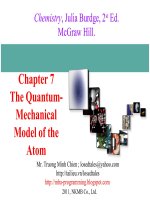The Document Object Model (DOM)
Bạn đang xem bản rút gọn của tài liệu. Xem và tải ngay bản đầy đủ của tài liệu tại đây (545.55 KB, 7 trang )
Tutorial – XML Programming in Java Section 3 – The Document Object Model (DOM)
9
Section 3 – The Document Object Model (DOM)
Dom, dom, dom, dom, dom,
Doobie-doobie,
Dom, dom, dom, dom, dom…
The DOM is a common interface for manipulating
document structures. One of its design goals is
that Java code written for one DOM-compliant
parser should run on any other DOM-compliant
parser without changes. (We’ll demonstrate this
later.)
As we mentioned earlier, a DOM parser returns a
tree structure that represents your entire document.
Sample code
Before we go any further, make sure you’ve
downloaded our sample XML applications onto
your machine. Unzip the file xmljava.zip, and
you’re ready to go! (Be sure to remember where
you put the file.)
DOM interfaces
The DOM defines several Java interfaces. Here
are the most common:
• Node: The base datatype of the DOM.
• Element: The vast majority of the objects
you’ll deal with are Elements.
• Attr: Represents an attribute of an element.
• Text: The actual content of an Element or
Attr.
• Document: Represents the entire XML
document. A Document object is often
referred to as a DOM tree.
Section 3 – The Document Object Model (DOM) Tutorial – XML Programming in Java
10
Common DOM methods
When you’re working with the DOM, there are
several methods you’ll use often:
• Document.getDocumentElement()
Returns the root element of the document.
• Node.getFirstChild() and
Node.getLastChild()
Returns the first or last child of a given Node.
• Node.getNextSibling() and
Node.getPreviousSibling()
Deletes everything in the DOM tree, reformats
your hard disk, and sends an obscene e-mail
greeting to everyone in your address book.
(Not really. These methods return the next or
previous sibling of a given Node.)
• Node.getAttribute(attrName)
For a given Node, returns the attribute with the
requested name. For example, if you want the
Attr object for the attribute named id, use
getAttribute("id").
<?xml version="1.0"?>
<sonnet type="Shakespearean">
<author>
<last-name>Shakespeare</last-name>
<first-name>William</first-name>
<nationality>British</nationality>
<year-of-birth>1564</year-of-birth>
<year-of-death>1616</year-of-death>
</author>
<title>Sonnet 130</title>
<lines>
<line>My mistress’ eyes are ...
Our first DOM application!
We’ve been at this a while, so let’s go ahead and
actually do something. Our first application simply
reads an XML document and writes the document’s
contents to standard output.
At a command prompt, run this command:
java domOne sonnet.xml
This loads our application and tells it to parse the
file sonnet.xml. If everything goes well, you’ll
see the contents of the XML document written out
to standard output.
The domOne.java source code is on page 33.
Tutorial – XML Programming in Java Section 3 – The Document Object Model (DOM)
11
public class domOne
{
public void parseAndPrint(String uri)
...
public void printDOMTree(Node node)
...
public static void main(String argv[])
...
domOne to Watch Over Me
The source code for domOne is pretty
straightforward. We create a new class called
domOne; that class has two methods,
parseAndPrint and printDOMTree.
In the main method, we process the command line,
create a domOne object, and pass the file name to
the domOne object. The domOne object creates a
parser object, parses the document, then
processes the DOM tree (aka the Document
object) via the printDOMTree method.
We’ll go over each of these steps in detail.
public static void main(String argv[])
{
if (argv.length == 0)
{
System.out.println("Usage: ... ");
...
System.exit(1);
}
domOne d1 = new domOne();
d1.parseAndPrint(argv[0]);
}
Process the command line
The code to process the command line is on the
left. We check to see if the user entered anything
on the command line. If not, we print a usage note
and exit; otherwise, we assume the first thing on
the command line (argv[0], in Java syntax) is the
name of the document. We ignore anything else
the user might have entered on the command line.
We’re using command line options here to simplify
our examples. In most cases, an XML application
would be built with servlets, Java Beans, and other
types of components; and command line options
wouldn’t be an issue.
public static void main(String argv[])
{
if (argv.length == 0)
{
System.out.println("Usage: ... ");
...
System.exit(1);
}
domOne d1 = new domOne();
d1.parseAndPrint(argv[0]);
}
Create a domOne object
In our sample code, we create a separate class
called domOne. To parse the file and print the
results, we create a new instance of the domOne
class, then tell our newly-created domOne object to
parse and print the XML document.
Why do we do this? Because we want to use a
recursive function to go through the DOM tree and
print out the results. We can’t do this easily in a
static method such as main, so we created a
separate class to handle it for us.
Section 3 – The Document Object Model (DOM) Tutorial – XML Programming in Java
12
try
{
DOMParser parser = new DOMParser();
parser.parse(uri);
doc = parser.getDocument();
}
Create a parser object
Now that we’ve asked our instance of domOne to
parse and process our XML document, its first
order of business is to create a new Parser
object. In this case, we’re using a DOMParser
object, a Java class that implements the DOM
interfaces. There are other parser objects in the
XML4J package, such as SAXParser,
ValidatingSAXParser, and
NonValidatingDOMParser.
Notice that we put this code inside a try block.
The parser throws an exception under a number of
circumstances, including an invalid URI, a DTD that
can’t be found, or an XML document that isn’t valid
or well-formed. To handle this gracefully, we’ll
need to catch the exception.
try
{
DOMParser parser = new DOMParser();
parser.parse(uri);
doc = parser.getDocument();
}
...
if (doc != null)
printDOMTree(doc);
Parse the XML document
Parsing the document is done with a single line of
code. When the parse is done, we get the
Document object created by the parser.
If the Document object is not null (it will be null
if something went wrong during parsing), we pass it
to the printDOMTree method.
public void printDOMTree(Node node)
{
int nodeType = Node.getNodeType();
switch (nodeType)
{
case DOCUMENT_NODE:
printDOMTree(((Document)node).
GetDocumentElement());
...
case ELEMENT_NODE:
...
NodeList children =
node.getChildNodes();
if (children != null)
{
for(inti=0;
i < children.getLength();
i++)
printDOMTree(children.item(i);
}
Process the DOM tree
Now that parsing is done, we’ll go through the DOM
tree. Notice that this code is recursive. For each
node, we process the node itself, then we call the
printDOMTree function recursively for each of the
node’s children. The recursive calls are shown at
left.
Keep in mind that while some XML documents are
very large, they don’t tend to have many levels of
tags. An XML document for the Manhattan phone
book, for example, might have a million entries, but
the tags probably wouldn’t go more than a few
layers deep. For this reason, stack overflow isn’t a
concern, as it is with other recursive algorithms.
Tutorial – XML Programming in Java Section 3 – The Document Object Model (DOM)
13
Document Statistics for sonnet.xml:
====================================
Document Nodes: 1
Element Nodes: 23
Entity Reference Nodes: 0
CDATA Sections: 0
Text Nodes: 45
Processing Instructions: 0
----------
Total: 69 Nodes
Nodes a-plenty
If you look at sonnet.xml, there are twenty-four
tags. You might think that would translate to
twenty-four nodes. However, that’s not the case.
There are actually 69 nodes in sonnet.xml; one
document node, 23 element nodes, and 45 text
nodes. We ran java domCounter sonnet.xml
to get the results shown on the left.
The domCounter.java source code is on page
35.
<?xml version=
"
1.0
"?>
<!DOCTYPE sonnet SYSTEM "sonnet.dtd">
<sonnet type="Shakespearean">
<author>
<last-name>Shakespeare</last-name>
Sample node listing
For the fragment on the left, here are the nodes
returned by the parser:
1. The Document node
2. The Element node corresponding to the
<sonnet> tag
3. A Text node containing the carriage return at
the end of the <sonnet> tag and the two
spaces in front of the <author> tag
4. The Element node corresponding to the
<author> tag
5. A Text node containing the carriage return at
the end of the <author> tag and the four
spaces in front of the <last-name> tag
6. The Element node corresponding to the
<last-name> tag
7. A Text node containing the characters
“Shakespeare”
If you look at all the blank spaces between tags,
you can see why we get so many more nodes than
you might expect.









